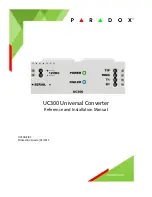
28
SDE-6S-ASI
User Manual
TS Bitrate:
user must select bitrate for the TS. Possible options are:
i. 19.39 Mbps –
Select this setting when the primary encoder output will be ASI for an ATSC application.
ii. 38.81 Mbps –
Select this setting if an external QAM 256 modulator(s) will be used with the encoder’s ASI
output(s).
Modulation Mode:
user can select the modulation mode. Possible options are: Reserved, Analog, QAM64, QAM256,
8-VSB, and 16-VSB.
Out of Band:
an out-of-band (OOB) is a channel which is the combination of the forward and reverse OOB channels.
When a cable virtual channel is flagged as being out-of-band, it is carried on the out-of-band channel. Possible options
are Enable, and Disable. When Enabled, assigns the OOB bit in the TS packet and labels the TS as out-of-band.
OUTPUT MAPPING:
Input:
indicates the list of the programs selected by the user that are included in the TS. It includes the Input
program number, video source, and audio source.
PID:
indicates the PID value assigned to each stream. PID (Packet Identifier) values are embedded by the content
provider in the MPEG-2 stream to identify tables and programming packets.
Program Number:
user must enter a unique output program number for each program. PMT (Program Map Table)
provides information on each program present in the transport stream such as program number, and the list of the
elementary streams (audio, video or data).
Short Name:
user may enter the short name of the channel. Up to 7 alphanumeric characters are allowed.
Major Channel:
user may enter the major channel number for the output program. The range is 1 to 99 for
Terrestrial and 1 to 999 for Cable.
Minor Channel:
user may enter minor channel number for the output program. The range is the range is 1 to 99 for
Terrestrial and 1 to 999 for Cable.
The PID value must be unique in a MPTS output stream. If a duplicate PID exists, assign a different
PID in the range of 48 to 8176 (recommended range provided by the international s.tandards)
The Program Number must be unique in a MPTS output stream. If a duplicate Program Number
exists, assign a different number in the range of 1 to 65535.
The channel number displayed on the screen is the combination of the major and minor channels. Make
sure that the major-minor channel pair is unique for each program on the MPTS output. For example, if
major channel = 6 and minor channel = 1, then the channel number displayed on TV would be 6-1.
MPTS Output Stream 'x' and MPTS Output Stream 'y' may have the same PID, Program Number,
Major-minor channel pair as each MPTS output stream is a unique stream.
Remember to click on the SAVE button to apply the new values/configurations.
3
4
2
1
2
5
6
3
4













































